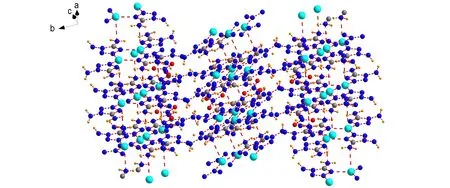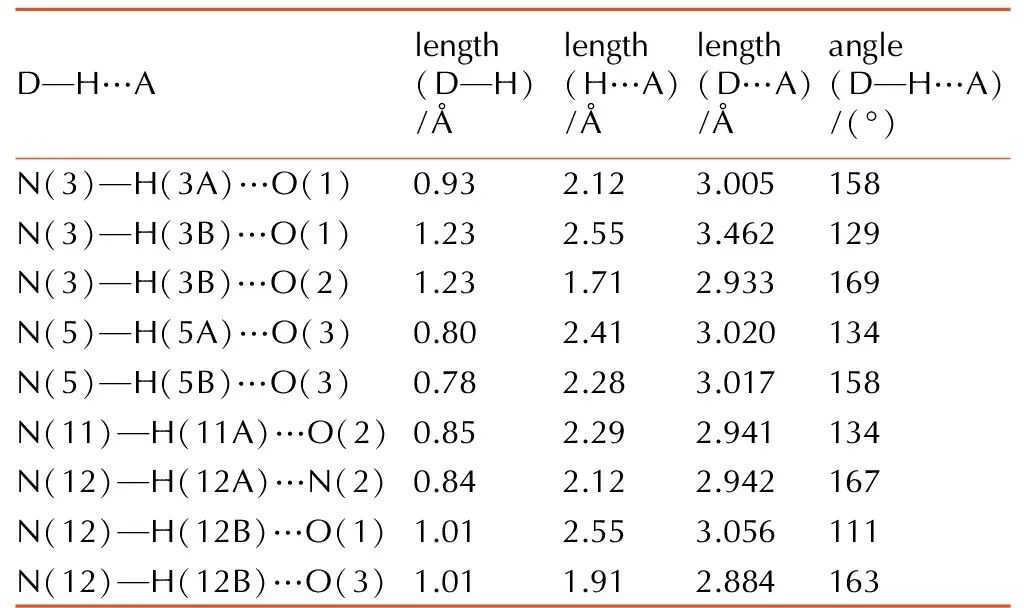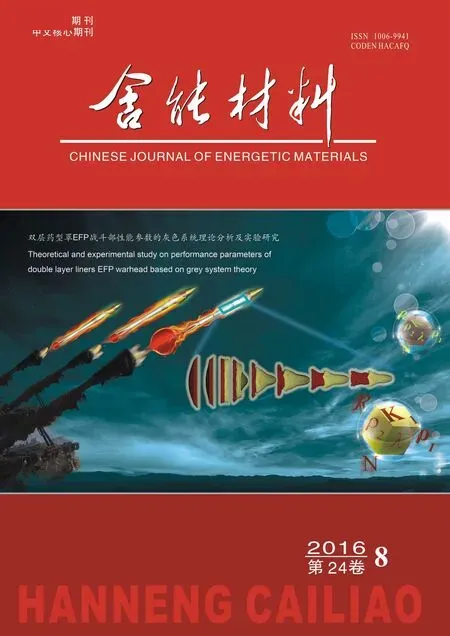含能配合物[Ag2(DAT)4](NO3)2(DAT=1,5-二氨基四唑)的合成、晶体结构及性能
张至斌, 许彩霞, 张建国, 殷 昕, 尹 磊
(北京理工大学爆炸科学与技术国家重点实验室, 北京 100081)
1 引 言
为满足日益增长的军事和民用领域的各种需求,设计研发具有优良爆轰性能,环境友好以及安全钝感等特点的新型高能量密度含能材料(HEDMs)显得尤为重要[1-4]。由四唑及其衍生物构成的高氮四唑类含能材料,因其具有良好的氧平衡,且分解产物主要为N2、对环境污染小等特点,已成为国内外重点研究方向之一[5-8]。含能配合物一般具有强烈爆炸特性,在起爆药、固体推进剂催化剂领域应用较多,其中以四唑类为配体的过渡金属含能配合物,由于其结构多样,且具有良好的能量性质,受到研究者的广泛关注[9-11]。
相对于5-氨基四唑,1,5-二氨基四唑(DAT)氮含量高达84%,其分解温度高达197 ℃,热稳定性较好。除1位N原子外,DAT分子中其他N原子均有形成配位键之可能,尤其是4位N原子[12-14]。本课题组合成出了一系列不同的含能配合物,如[Cd(DAT)6](ClO4)2,[Mn(DAT)6](ClO4)2,[Zn(DAT)6](ClO4)2, [Co(DAT)6](PA)2·4H2O,[Cu(DAT)2(PA)2]等,并研究了其晶体结构、热性能及感度性能,结果表明这些含能配合物有望应用于含能材料领域[15-19]。
基于此,本研究以DAT和硝酸银为原料,合成了新型高氮含能配合物——[Ag2(DAT)4](NO3)2,并采用元素分析、傅里叶变换红外光谱(FTIR)对其进行表征。利用X-射线单晶衍射仪(XRD)对其晶体结构进行测定。采用差示扫描量热(DSC)技术研究其热分解性能,计算得到其非等温动力学参数和热爆炸临界温度等热力学参数。利用氧弹量热技术测定其燃烧热,并计算其标准生成焓。最后测试其撞击、摩擦和火焰感度等,为其后续应用提供基础数据。
2 实验部分
2.1 试剂和仪器
试剂: AgNO3、氨基硫脲、氧化铅、乙醇等,国药集团化学试剂有限公司,分析纯; DAT为实验室参照文献[20]方法自制,精制后用于后续实验,实验用水为去离子水。
仪器及测试条件: Thermo Electron SPA公司Flash EA 1112全自动微量元素分析仪; Nicolet公司傅里叶变换红外光谱仪: KBr压片,扫描范围4000~400 cm-1,分辨率6 cm-1; Bruker SMART APEX CCD单晶衍射仪; Perkin-Elmer公司Pyris-1型热分析仪: 流动N2气氛,流速 20 mL·min-1; Parr公司6200氧弹量热仪。
2.2 合成过程
称取DAT 0.41 g (5 mmol)溶解于20 mL去离子水中作为底液,在75 ℃下加热搅拌, 称取AgNO30.34 g (2 mmol)溶于5 mL去离子水中并缓慢滴加入底液,反应60 min后冷却至室温,过滤,去离子水洗涤两遍,乙醇洗涤两遍并干燥,得到白色粉末产物0.64 g,收率86%。母液在室温下缓慢蒸发,4天后得到可用于结构测定的透明块状晶体。IR (KBr,ν/cm-1): 3324, 3153, 1657, 1383, 1110, 1077, 1003, 935, 699, 605。Anal. calcd for C4H16Ag2N26O6(740.17): C 6.49,H 2.18,N 49.21; found C 6.47,H 2.15,N 49.26。
2.3 晶体结构分析
选取尺寸为0.10 mm×0.15 mm×0.17 mm的晶体,采用Bruker SMART APEX CCD单晶衍射仪,以石墨单色器单色化的Mo Kα射线(λ=0.071073 nm)为光源,通过ω-θ扫描方式在90(2)K,2.07°≤θ≤27.50°下收集11692个衍射点,其中2526个独立衍射点[R(int)=0.019],所有强度数据进行Lp因子及经验吸收校正。晶体结构通过直接法由SHELXS-97解析得到[21],并由全矩阵最小二乘法精修由SHELXL-97程序完成[22]。非氢原子由直接法获得,氢原子通过理论加氢获得。详细参数见表1。该晶体CIF文件已保存在剑桥晶体结构数据中心(CCDC No. 913276)。
3 结果与讨论
3.1 晶体分析
高氮含能配合物[Ag2(DAT)4](NO3)2属于单斜晶系,P21/n空间群,其结构及堆积图分别见图1和图2。表2、表3和表4分别列出该配合物晶体结构的部分键长键角以及氢键数据。

表1[Ag2(DAT)4](NO3)2的晶体结构数据和结构精修参数
Table1Crystal data and structure refinement details for [Ag2(DAT)4](NO3)2

parameter[Ag2(DAT)4](NO3)2empiricalformulaC4H16Ag2N26O6formulamass740temperature/K90(2)crystalsystemmonoclinicspacegroupP21/nZ2a/Å6.8109(9)b/Å19.654(3)c/Å8.4510(11)β/(°)102.590(3)cellvolume/Å31104.1(3)Dc/g·cm-32.190μ(MoKα)/Å0.71073θ/(°)2.07-27.50h,k,andlrange-8-8,-25-25,-10-10reflectionscollected11692reflectionsunique[Rint]2526[Rint=0.019]data/restraint/parameter2526/0/205goodness⁃of⁃fitonF21.583R1,wR2[I>2σ(I)]R1=0.0339,wR2=0.1645R1,wR2(alldata)R1=0.0342,wR2=0.1649Δρmax,Δρmin(e·Å-3)1.70,-2.19


图1[Ag2(DAT)4](NO3)2的分子结构
Fig.1Molecular structure of [Ag2(DAT)4](NO3)2

图2[Ag2(DAT)4](NO3)2的堆积图
Fig.2Packing diagram of [Ag2(DAT)4](NO3)2
表2[Ag2(DAT)4](NO3)2的部分键长
Table2Selected bond lengths for [Ag2(DAT)4](NO3)2

bondlength/Åbondlength/Åbondlength/ÅAg(1)—N(1)2.259(3)N(8)—N(9)1.294(4)N(3)—C(1)1.336(5)Ag(1)—N(7)2.285(2)N(9)—N(10)1.361(4)N(4)—N(5)1.398(4)Ag(1)—N(8a)#12.231(3)N(9)—N(10)1.361(4)N(4)—N(6)1.372(4)N(10)—N(11)1.402(4)N(1)—N(6)1.290(4)N(4)—C(1)1.347(4)N(10)—C(2)1.338(4)N(1)—N(2)1.367(5)N(7)—C(2)1.330(5)N(12)—C(2)1.346(4)N(2)—C(1)1.341(5)N(7)—N(8)1.370(4)N(13)—O(1)1.231(4)N(13)—O(2)1.255(4)N(13)—O(3)1.284(4)
Note: #1: -x,-y,1-z
表3[Ag2(DAT)4](NO3)2的部分键角
Table3Selected bond angles for [Ag2(DAT)4](NO3)2

bondangle/(°)bondangle/(°)N(1)—Ag(1)—N(7)109.8(11)Ag(1a)#1—N(8)—N(7)123.5(2)N(1)—Ag(1)—N(8a)#1135.6(10)Ag(1a)#1—N(8)—N(9)124.7(2)N(7)—Ag(1)—N(8a)#1113.9(11)N(8)—N(9)—N(10)104.9(3)Ag(1)—N(1)—N(2)117.8(2)N(9)—N(10)—N(11)124.6(3)Ag(1)—N(1)—N(6)129.0(2)N(9)—N(10)—C(2)110.1(3)N(2)—N(1)—N(6)112.5(3)N(11)—N(10)—C(2)124.8(3)N(1)—N(2)—C(1)105.4(3)O(1)—N(13)—O(3)119.3(3)N(5)—N(4)—N(6)124.8(3)O(1)—N(13)—O(2)121.8(3)N(5)—N(4)—C(1)125.8(3)O(2)—N(13)—O(3)118.9(3)N(6)—N(4)—C(1)109.4(3)N(2)—C(1)—N(4)107.7(3)N(1)—N(6)—N(4)105.1(3)N(2)—C(1)—N(3)127.7(3)Ag(1)—N(7)—C(2)131.7(2)N(3)—C(1)—N(4)124.6(3)N(8)—N(7)—C(2)105.8(2)N(7)—C(2)—N(12)128.5(3)N(7)—N(8)—N(9)111.8(3)N(7)—C(2)—N(10)107.5(3)Ag(1)—N(7)—N(8)122.5(2)N(10)—C(2)—N(12)123.8(3)
Note: #1: -x,-y,1-z

表4[Ag2(DAT)4](NO3)2的部分氢键
Table4Selected hydrogen bonds for [Ag2(DAT)4](NO3)2

D—H…Alength(D—H)/Ålength(H…A)/Ålength(D…A)/Åangle(D—H…A)/(°)N(3)—H(3A)…O(1)0.932.123.005158N(3)—H(3B)…O(1)1.232.553.462129N(3)—H(3B)…O(2)1.231.712.933169N(5)—H(5A)…O(3)0.802.413.020134N(5)—H(5B)…O(3)0.782.283.017158N(11)—H(11A)…O(2)0.852.292.941134N(12)—H(12A)…N(2)0.842.122.942167N(12)—H(12B)…O(1)1.012.553.056111N(12)—H(12B)…O(3)1.011.912.884163
3.2 热行为分析
10 ℃·min-1时含能配合物[Ag2(DAT)4](NO3)2的DSC曲线如图3所示。由图3可知,目标配合物的热分解行为包含一个吸热过程和一个放热过程,其吸热过程起始于188 ℃,其尖锐吸热峰温度为196.2 ℃,该过程为[Ag2(DAT)4](NO3)2的晶体熔化过程。熔化后该配合物立即放热分解,放热峰出现在202~256 ℃之间,其放热峰温度为228.6 ℃。

图3[Ag2(DAT)4](NO3)2的DSC曲线(10 ℃·min-1)
Fig.3DSC curve of [Ag2(DAT)4](NO3)2at heating rate of 10 ℃·min-1
测定[Ag2(DAT)4](NO3)2在5、10、15、20 ℃·min-1四种线性升温速率下的DSC曲线,得到其在不同升温速率下放热峰的峰温数据,列于表5。根据Kissinger法[24]和Ozawa-Doyle[25]法计算其放热分解反应的表观活化能Ea和指前因子A,两种方法的计算公式如式(1)和式(2)所示:
(1)
(2)
式中,Tp为放热分解峰温,℃,由DSC曲线得到;R为气体常数,8.314 J·mol-1·℃-1;β为线性升温速率,℃·min-1;C为常数,应用两种方法计算得到的非等温动力学参数同样列于表5。
表5[Ag2(DAT)4](NO3)2的放热分解峰温度及非等温动力学参数
Table5Peak temperatures and non-isothermal kinetic parameters for the exothermic decomposition of [Ag2(DAT)4](NO3)2

β/℃·min-1Tp/℃EK/kJ·mol-1lg(AK/s-1)RKEO/kJ·mol-1 RO5222.310228.615233.120235.8204.919.54-0.9993 202.8-0.9993
Note:βis the heating rate;Tpis the peak temperatures;Eis the apparent activation energy.Ais the pre-exponential factor.Ris the linear correlation coefficient. The subscript K and O represent Kissinger′s method and Ozawa′s method, respectively.
由表5可以看出,通过两种方法所计算得到的[Ag2(DAT)4](NO3)2表观活化能结果相近,分别为204.9 kJ·mol-1和202.8 kJ·mol-1,且可以得到其热分解的Arrhenius方程为: lnk=19.54-203.9×103/RT,其中k为非等温动力学反应速率常数。
3.3 标准生成焓及热爆炸临界温度计算
对新型含能配合物,燃烧热和生成焓是评价其含能特性的重要参数。选择Parr公司1104型氧弹,充氧1 min,使内部气压达到3.0 MPa,测试条件为室温25 ℃,相对湿度30%,药量500 mg。平行测试5次,测定[Ag2(DAT)4](NO3)2的定容燃烧热(Qv)为-4177.59 kJ·mol-1。通过其燃烧反应方程式(3)和计算式(4)得到其定压燃烧热(ΔH)为-4149.08 kJ·mol-1。
C4H16Ag2N26O6(s)+11/2O2(g)= Ag2O(s)+4CO2(g)+
8H2O(l)+13N2(g)
(3)
ΔH=Qp=Qv+ΔnRT
(4)
4ΔfHΘ(CO2,g)-ΔcHΘ(s)
(5)
通常采用热爆炸临界温度(Tbp)来评估含能材料的热安全性。根据热爆炸临界温度估算式[27-29],当升温速率β→0时,所对应的分解峰值温度可通过下式进行估算:
Tpi=Tp0+aβ+bβ2+cβ3
(6)
式中,Tpi为升温速率βi时的峰温,℃;a、b、c为常数。通过待定系数拟合方程求得升温速率β→0时对应的峰温为Tp0=214.2 ℃。然后根据方程(7)[27-29],求得目标配合物的热爆炸临界温度Tbp=224.4 ℃:
(7)
同时由下述方程可计算得到热力学参数ΔS≠,ΔH≠和ΔG≠的值[27-29]:
(8)
ΔH≠=E-RT
(9)
ΔG≠=ΔH≠-TΔS≠
(10)
式中,E为Ozawa方法计算得到的活化能,kB为玻尔兹曼常数,1.381×10-23J·K-1;h为普朗克常数,6.626×10-34J·s-1。最终计算得到的热力学参数分别为ΔS≠= -86.54 J·K-1·mol-1; ΔH≠= 200.85 kJ·mol-1; ΔG≠=243.02 kJ·mol-1。
3.4 感度性能研究
按照GJB5891.22-2006、GJB5891.24-2006、GJB5891.25-2006,测试[Ag2(DAT)4](NO3)2的撞击感度、摩擦感度和火焰感度。采用CGY-1型机械撞击感度仪,测试条件为药量0.02 g,压药压强39.2 MPa,落锤800 g,升降法测试[Ag2(DAT)4](NO3)2的撞击感度H50为0,表明其对撞击钝感; 采用MGY-1摆式摩擦感度仪,测试条件为药量0.02 g,摆锤1.5 kg,摆角90°,表压1.96 MPa,测试结果表明[Ag2(DAT)4](NO3)2摩擦感度发火率为40%; 采用HGY-1型火焰感度仪,测试条件为药量0.02 g,压药压强58.8 MPa,标准黑药柱(WJ636)点火,升降法测试[Ag2(DAT)4](NO3)2的火焰感度H50为0,表明其对火焰钝感。
由上述结果可知,[Ag2(DAT)4](NO3)2对外界摩擦刺激较敏感,对机械撞击和火焰刺激钝感,属于钝感含能材料。
4 结 论
(1) 以1,5-二氨基四唑及AgNO3为起始原料合成新型高氮含能配合物[Ag2(DAT)4](NO3)2,收率86%,并通过元素分析、红外光谱对其结构进行了表征。
(2) [Ag2(DAT)4](NO3)2的单晶分析结果表明,该配合物属于双核结构,中心Ag+和来自三个DAT分子的六个N原子配位形成畸变四面体结构,同时一个结构单元中两个Ag+和四个N原子形成平面六元环结构。此外分子中含有一定数量的氢键,有助于提高其结构稳定性。
(3) DSC分析表明[Ag2(DAT)4](NO3)2分解过程经历一个吸热过程和一个放热过程,放热峰温为228.6 ℃。运用Kissinger法和Ozawa-Doyle法计算得其表观活化能分别为204.9 kJ·mol-1和202.8 kJ·mol-1,其标准生成焓为258.14 kJ·mol-1,热爆炸临界温度Tbp=224.4 ℃,其热力学参数分别为ΔS≠=-86.54 J·K-1·mol-1; ΔH≠=200.85 kJ·mol-1; ΔG≠=243.02 kJ·mol-1。
(4) 感度测试表明该配合物对摩擦刺激较敏感,但对撞击和火焰刺激钝感,属于钝感含能材料。
参考文献:
[1] Klapötke T M, Petermayer C, Piercey D C, et al. 1,3-Bis(nitroimido)-1,2,3-triazolate anion, theN-nitroimide moiety, and the strategy of alternating positive and negative charges in the design of energetic materials[J].JournaloftheAmericanChemicalSociety, 2012, 134(51): 20827-20836.

[3] Ye C F, Gard G L, Winter R W, et al. Synthesis of pentafluorosulfanylpyrazole and pentafluorosulfanyl-1,2,3-trizole and their derivatives as energetic materials by click chemistry[J].OrganicLetters, 2007, 9(19): 3841-3844.
[4] Sun Q, Li Z, Xu K Z, et al. Synthesis and characterization of a new cadmium complex based on 1,1-diamino-2,2-dinitroethylene[J].JournalofCoordinationChemistry, 2014, 67(15): 2576-2582.
[5] Gao H X, Shreeve J M. Azole-based energetic salts[J].ChemicalReview, 2011, 111(11):7377-7436.
[6] Klapötke T M, Karaghiosoff K, Mayer P, et al. Synthesis and characterization of 1,4-dimethyl-5-aminotetrazolium 5-nitrotetrazolate[J].Propellants,Explosives,Pyrotechnics, 2006, 31(3): 188-195.
[7] Klapotke T M, Sabate C M, Stierstorfer J. Neutral 5-nitrotetrazoles: easy initiation with low pollution[J].NewJournalofChemistry, 2009, 33(1): 136-147.
[8] Joo Y-H, Shreeve J M. Nitroimino-tetrazolates and oxy-nitroimino-tetrazolates[J].JournaloftheAmericanChemicalSociety, 2010, 132(42): 15081-15090.
[9] Joo Y-K, Twamley Brendan, Shreeve J M. Carbonyl and oxalyl bridged bis(1,5-diaminotetrazole)-based energetic salts[J] .ChemistryAEuropeanJournal, 2009, 15(36): 9097-9104.
[10] Fischer N, Klapötke T M,Piercey D G, et al. Hydroxylammonium 5-nitriminotetrazolated[J].Z.Anorg.Allg.Chem, 2012, 638(2): 302-310.
[11] Klapötke T M, Piercey D G. 1,1′-Azobis(tetrazole): a highly energetic nitrogen-rich compound with a N10chain[J].InorgnicChemistry, 2011, 50(7): 2732-2734.
[12] Li Z M, Zhang J G, Yang W, et al. Synthesis and strucutre characterization of a new 1D polymeric energetic complex [Hg(DAT)6Cl2]n(DAT=1,5-diaminotetrazole)[J] .ChineseJournalofStrucutreChemistry, 2013, 32(5): 653-658.
[13] 齐书元, 张同来, 杨利, 等. 1,5-二氨基四唑及其系列化合物研究进展[J]. 含能材料, 2009, 17(4): 486-490.
QI Shu-yuan, ZHANG Tong-lai, YANG Li, et al. Progress in 1,5-diamino-1H-tetrazole and its derivatives[J].ChineseJournalofEnergeticMaterials(HannengCailiao), 2009,17(4): 486-490.
[14] Zhai Q G, Li S N, Gao X, et al. Self-assembly of a novel 3D copper-tetrazolate supramolecular framework via interpenetration porous 2D double-layer motifs[J].InorganicChemistryCommunications, 2010, 13(1): 211-214.
[15] Cui Y, Zhang J G, Zhang T L, et al. Synthesis, structural investigation, thermal decomposition mechanism and sensitivity properties of an energetic compound [Cd(DAT)6](ClO4)2(DAT=1,5-diamiontetrazole)[J].JournalofHazardousMaterials, 2008, 160(1): 45-50.
[16] Cui Y, Zhang T L, Zhang J G. Study on crystal structure and thermal decomposition mechanism of a novel coordination compound [Zn(DAT)2(H2O)4](PA)2·2H2O[J].Propellants,Explosives,Pyrotechnics, 2008, 33(6): 437-442.
[17] Cui Y, Zhang J G, Zhang T L, et al. Synthesis, structural investigation and thermal analyses of a novel coordination compound [Cd(DAT)6](HTNR)2·3.5H2O (DAT=1,5-diamiontetrazole)[J].JournalofMolecularStructure, 2008, 889(1-3): 177-185.
[18] 尚静, 张建国, 崔燕, 等. 含能配合物[Zn(DAT)6](ClO4)2(DAT=1,5-二氨基四唑)的合成、晶体结构及性能[J]. 化学学报, 2010, 68(3): 233-236.
SHANG Jing, ZHANG Jian-guo, CUI Yan, et al. Synthesis, crystal structure, and properties of an energetic compound [Zd(DAT)6](ClO4)2[J].ActaChimicaSinica, 2010, 68(3): 233-236.
[19] Bi Y G, Feng Y A, Zhang T L,et al. Synthesis, structure, and ermal decomposition of two copper coordination compounds [Cu(DAT)2(PA)2] and [Cu(DAT)2(HTNR)2] with nitrogen rich 1,5-diaminotetrazole(DAT)[J].JournalofCoordinationChemistry,2015,68(1):181-194.
[20] Gálvez-Ruiz J C, Holl G, Klapötke, T.M, et al. Derivatives of 1,5′-diamino- 1h-tetrazole: a new family of energetic heterocyclic- based sals[J].InorgnicChemistry, 2005, 44(12): 4237-4253.
[21] Sheldrick G M, SHELXS-97, Program for solution of crystalstructures[CP], University of Gottingen, Germany, 1990.
[22] Sheldrick G M, SHELXL-97, Program for refinement of crystalstructures[CP], University of Gottingen, Germany, 1997.
[23] 齐书元, 张建国, 张同来, 等. 含能配合物[Mn(DAT)6](ClO4)2的合成、晶体结构、热行为及感度性质[J]. 高等学校化学学报, 2009,30(10): 1935-1939.
QI Shu-yuan, ZHANG Jian-guo, ZHANG Tong-lai, et al. Synthesis, crystal structure, thermal behavior and sensitivity propertse of a new energetic compound [Mn(DAT)6](ClO4)2[J]ChemicalJournalofChineseUniversities, 2009, 30(10): 1935-1939.
[24] Kissinger H E. Reaction kinetics in differential thermal analysis[J].AnalChem, 1957, 19: 1702-1706.
[25] Ozawa T. A new method of analyzing thermogravimetric data bull[J].ChemSocJpn, 1965, 38: 1881-1886.
[26] Li F G, Bi Y G, Zhang T L, et al. Nitrogen-rich salts based on the energetic[monoaquabis(N,N-bis(1H-tetrazol-5-yl)amine)-zine] anion: a promising design in the development of new energetic materials[J].InorgnicChemistry, 2015, 54: 2050-2057.
[27] 胡拥鹏,赵旭芳,赵宁宁,等. DNGTz的非等温热分解动力学及热安全性[J]. 含能材料, 2014, 22(6): 767-773.
HU Yong-peng, ZHAO Xu-fang, ZHAO Ning-ning, et al. Non-isothermalthermal decomposition kinetics and thermal safety of DNGTz[J].ChineseJournalofEnergeticMaterials(HannengCailiao), 2014, 22(6): 767-773.
[28] ZHANG Tong-lai, HU Rong-zu, XIE Yi, et al. The estimation of critical temperature of thermal explosion for energetic materials using non-isothermal DSC[J].ThermochimicaActa, 1994, 244(2): 171-176.
[29] Zhang Hang, Xu Kang-zhen, Gao Shuai, et al. Characterization and thermal properties of 2-(dinitromethylene)-1,3-diazacyclopentane guanidine salt[J].IndianJournalofChemistry, 2013, 52: 473-479.

